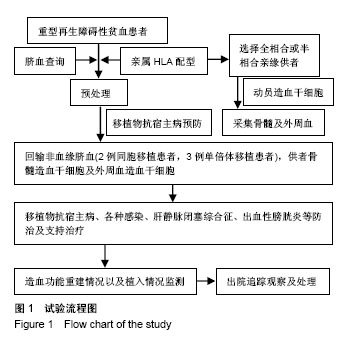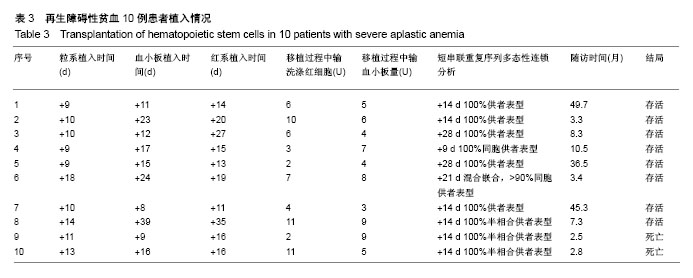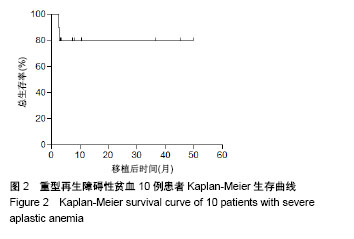| [1] 张然,夏凌辉.重型再生障碍性贫血的移植治疗[J].临床内科杂志, 2017,34(12):803-806. [2] Bacigalupo A, Brand R, Oneto R, et al. Treatment of acquired severe aplastic anemia: bone marrow transplantation compared with immunosuppressive therapy--The European Group for Blood and Marrow Transplantation experience. Semin Hematol. 2000;37(1):69-80.[3] 付蓉. 再生障碍性贫血诊断与治疗中国专家共识(2017年版)[J]. 中华血液学杂志, 2017,38(1):1-5.[4] Bacigalupo A. How I treat acquired aplastic anemia. Blood. 2017;129(11):1428-1436.[5] Killick SB, Bown N, Cavenagh J, et al. Guidelines for the diagnosis and management of adult aplastic anaemia. Br J Haematol. 2016;172(2):187-207.[6] Gupta V, Eapen M, Brazauskas R, et al. Impact of age on outcomes after bone marrow transplantation for acquired aplastic anemia using HLA-matched sibling donors. Haematologica. 2010;95(12):2119-2125.[7] Sangiolo D, Storb R, Deeg HJ, et al. Outcome of allogeneic hematopoietic cell transplantation from HLA-identical siblings for severe aplastic anemia in patients over 40 years of age. Biol Blood Marrow Transplant. 2010;16(10):1411-1418.[8] Shibuya A, Ishii S, Obinata K. Successful bone marrow plus cord blood stem cell transplantation in a girl who developed myelodysplastic syndrome from hepatitis-associated aplastic anemia treated with long-term immunosuppressants and growth factors. Hematology. 2002;7(5):301-304.[9] Fernández MN. Improving the outcome of cord blood transplantation: use of mobilized HSC and other cells from third party donors. Br J Haematol. 2009;147(2):161-176.[10] Sánchez-Ortega I, Arnan M, Patiño B, et al. Early engraftment and full-donor chimerism after single-cord blood plus third-party donor dual transplantation in patients with high-risk acute leukemia. Bone Marrow Transplant. 2014;49(1): 145-147.[11] van Besien K, Hari P, Zhang MJ, et al. Reduced intensity haplo plus single cord transplant compared to double cord transplant: improved engraftment and graft-versus-host disease-free, relapse-free survival. Haematologica. 2016; 101(5):634-643.[12] Yamei W, Rongmu L, Yongbin C, et al. Improved outcome of haploidentical transplantation in severe aplastic anemia using reduced-intensity fludarabine-based conditioning. Oncotarget. 2017;8(48):83817-83830.[13] Xu L, Liu Z, Wu Y, et al. Clinical evaluation of haploidentical hematopoietic combined with human umbilical cord-derived mesenchymal stem cells in severe aplastic anemia. Eur J Med Res. 2018;23(1):12.[14] 郭智,陈惠仁,刘晓东,等. 低强度预处理联合移植后诱导免疫耐受的单倍体相合Allo-HSCT治疗重型再生障碍性贫血的临床疗效研究[J].中国实验血液学杂志,2016,24(6):1811-1816.[15] Xu LP, Jin S, Wang SQ, et al. Upfront haploidentical transplant for acquired severe aplastic anemia: registry-based comparison with matched related transplant. J Hematol Oncol. 2017;10(1):25.[16] Im HJ, Koh KN, Choi ES, et al. Excellent outcome of haploidentical hematopoietic stem cell transplantation in children and adolescents with acquired severe aplastic anemia. Biol Blood Marrow Transplant. 2013;19(5):754-759.[17] Penack O, Tridello G, Hoek J, et al. Influence of pre-existing invasive aspergillosis on allo-HSCT outcome: a retrospective EBMT analysis by the Infectious Diseases and Acute Leukemia Working Parties. Bone Marrow Transplant. 2016; 51(3):418-423.[18] Maury S, Bacigalupo A, Anderlini P, et al. Improved outcome of patients older than 30 years receiving HLA-identical sibling hematopoietic stem cell transplantation for severe acquired aplastic anemia using fludarabine-based conditioning: a comparison with conventional conditioning regimen. Haematologica. 2009;94(9):1312-1315.[19] 吴祥元.外周血干细胞移植的临床应用[J].实用医学杂志, 2000, 16(1):8.[20] 胡亮钉,陈虎,江岷,等.异基因外周血造血干细胞移植治疗骨髓增生异常综合征23例疗效分析[J].中华血液学杂志, 2006,27(8): 522-524.[21] Schrezenmeier H, Passweg JR, Marsh JC, et al. Worse outcome and more chronic GVHD with peripheral blood progenitor cells than bone marrow in HLA-matched sibling donor transplants for young patients with severe acquired aplastic anemia. Blood. 2007;110(4):1397-1400.[22] Bacigalupo A, Socié G, Schrezenmeier H, et al. Bone marrow versus peripheral blood as the stem cell source for sibling transplants in acquired aplastic anemia: survival advantage for bone marrow in all age groups. Haematologica. 2012; 97(8):1142-1148.[23] 黄晓军,陈育红,许兰平,等. G-CSF动员的骨髓及外周血干细胞移植治疗重型再生障碍性贫血[J]. 基础医学与临床, 2004, 24(3):54-57.[24] 刘会兰,孙自敏,耿良权,等.G-CSF动员后异基因骨髓联合外周血干细胞移植治疗血液病[J].临床内科杂志,2008,25(6):374-376.[25] Ali AS, Al-Shraim M, Al-Hakami AM, et al. Epstein- Barr Virus: Clinical and Epidemiological Revisits and Genetic Basis of Oncogenesis. Open Virol J. 2015;9:7-28.[26] 刘丽,冯四洲.异基因造血干细胞移植后EB病毒相关淋巴增殖性疾病研究进展[J].中华血液学杂志,2017,38(9):817-821.[27] 韩婷婷,许兰平,刘代红,等.异基因造血干细胞移植后EB病毒感染情况分析[J]. 中华血液学杂志, 2013, 34(8): 651-654.[28] Styczynski J, van der Velden W, Fox CP, et al. Management of Epstein-Barr Virus infections and post-transplant lymphoproliferative disorders in patients after allogeneic hematopoietic stem cell transplantation: Sixth European Conference on Infections in Leukemia (ECIL-6) guidelines. Haematologica. 2016;101(7):803-811.[29] Morscio J, Tousseyn T. Recent insights in the pathogenesis of post-transplantation lymphoproliferative disorders. World J Transplant. 2016;6(3):505-516.[30] Patriarca F, Medeot M, Isola M, et al. Prognostic factors and outcome of Epstein-Barr virus DNAemia in high-risk recipients of allogeneic stem cell transplantation treated with preemptive rituximab. Transpl Infect Dis. 2013;15(3):259-267.[31] Kobayashi S, Sano H, Mochizuki K, et al. Pre-emptive rituximab for Epstein-Barr virus reactivation after haplo-hematopoietic stem cell transplantation. Pediatr Int. 2017;59(9):973-978. |
.jpg)



.jpg)
.jpg)
.jpg)
.jpg)